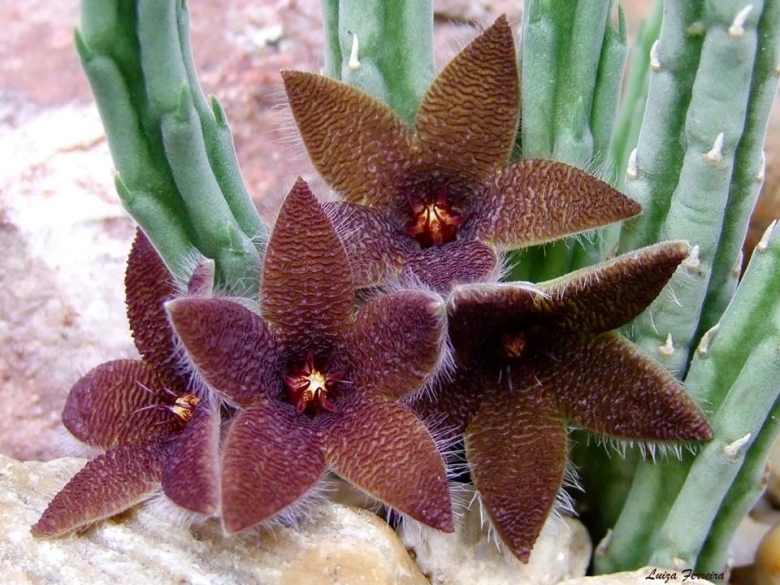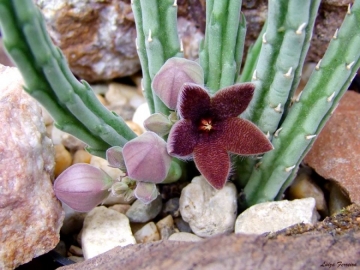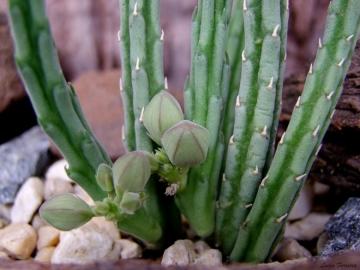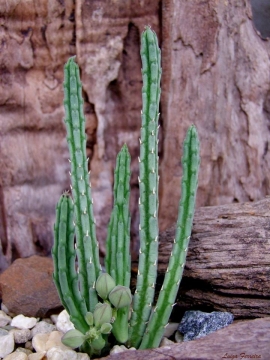
Stapelia olivacea Photo by: Luiza Ferreira
Origin and Habitat: Stapelia olivaceaSN|30268]]SN|30268]] is a South African endemic found in the Eastern Cape, Free State, Northern Cape, and Western Cape
Altitude range: 900 - 1100 metres above sea level.
Habitat and ecology: This species grows amongst stones and boulders in mountainous areas. Despite its wide range, it is locally very rare and does not appear to be common anywhere today.
Synonyms:
See all synonyms of Stapelia olivacea
back
Accepted name in llifle Database:Stapelia olivacea N.E.Br.Gard. Chron. (1875) I. 136Synonymy: 3
back
Common Names include:
ENGLISH: Carrion flower, African starfish flower
AFRIKAANS (Afrikaans): Aasblom, Agurkie
Description: Stapelia olivaceaSN|30270]]SN|30268]] is an uncommon S. African tufted species stems about 10 cm tall. It has few-flowered basal inflorescences with small evil-scented flowers (up to 4 cm in diameter), held distinctively upright, reddish-yellow, olive-green, sometimes almost black in colour with transverse brown lines in which the corolla-lobes are ciliate with flat non-vibratile hairs. The plants are large and rather compactly branched at the base with thin fuzzy grey stems held erect in a closely parallel grouping, that sometimes spread for up to 50 or more cm. It is closely related to Stapelia pearsoniiSN|30268]]SN|30270]].
Stems: Erect, apically tapering, 4-12.5 cm high, basally 8-12 mm in diameter, very obtusely 4-angled, with the faces slightly grooved, not toothed on the angles, but with an impressed transverse line at the base of the erect 1-1.5 mm long rudimentary leaves, these caducous wih mall stipular rudiments. Epidermis minutely puberulous, very smooth-looking, grey-green, with the grooves and impressed lines darker green or purple, usually blotched with purple where exposed to the sun.
Flowers: 1-2(-6) together at the base of the young stems with strong, fetid odour. Flower buds compressed-ovoid, obtusely 5-angled. Pedicels 2-6 (in fruit 12-16) mm long, pubescent. Sepals 4-5 mm long, lanceolate-subulate, pubescent. Corolla campanulate, when fully expanded 2.5 to 4 cm in diameter, with very spreading or slightly recurved lobes 10-14 mm long, 8-10 mm broad, ovate to long-attenuate-triangular, acute, weakly pubescent and dull green on the back, inner face deeply and closely rugose, glabrous, greenish-yellow, to pale olive green, dark olive, maroon, to almost black wrinkles red-brown, labyrinth-like, margins densely hairy, hairs simple white, weak. Corona dark purple: Outer corona-lobes weakly concave, ascending-spreading, 2-3 mm long, narrowly narrowly triangular, acute, dark purple-brown, with a smooth polished central stripe from the base to the middle. Inner corona-lobes 2-horned, dark purple-brown; inner horn 4-5 mm long, erect or very slightly recurving, apical appendage slenderly filiform, apically shortly subulate, connivent over the anthers. Outer horn erectly recurved, 1.5-3 mmlong, falcately subulate, laterally compressed. Pollinia 0.5-0.7 x 0.4 - 055 mm.
Fruits:* Follicles pale olive-brown, 8-10 cm long, about 6 mm thick, narrowly fusiform, acute, puberulous.
Chromosome number: 2n = 22.
Bibliography: Bibliography for Southern Africa :
1) Focke Albers und Ulli Meve (Hrsg.): “Sukkulenten-Lexikon" Volume 3 Asclepiadaceae” Ulmer, Stuttgart 2002N. E. Brown “Flora Capensis” Vol 4, page 518, 1909
2) Focke Albers und Ulli Meve (Hrsg.): “Sukkulenten-Lexikon" Volume 3 Asclepiadaceae” Ulmer, Stuttgart 2002
3) “The Flowering Plants of Africa: A Magazine Containing Coloured Figures with Descriptions of the Flowering Plants Indigenous in Africa ...”, Botanical Research Institute (South Africa), South Africa. Dept. of Agricultural Technical Services Volume 12: t.455 1932
4) List South. African Succ. Pl. : 30 1997
5) Schmelzer, G.H. & Gurib-Fakim, A “Medicinal plants 2" Prota, 2013
6) Foden, W. & Potter, L. 2005. “Stapelia olivacea N.E.Br." National Assessment: Red List of South African Plants version 2014.1. Accessed on 2015/03/08
 Stapelia olivacea Photo by: Luiza Ferreira
Stapelia olivacea Photo by: Luiza Ferreira Stapelia olivacea Photo by: Luiza Ferreira
Stapelia olivacea Photo by: Luiza Ferreira Stapelia olivacea Photo by: Luiza Ferreira
Stapelia olivacea Photo by: Luiza FerreiraSend a photo of this plant.The gallery now contains thousands of pictures, however it is possible to do even more. We are, of course, seeking photos of species not yet shown in the gallery but not only that, we are also looking for better pictures than those already present.
Read More... Cultivation and Propagation: Stapelia olivaceaSN|30268]]SN|30268]] is a quick-growing species that blooms easyly when mature. They require moderately watering through the growing season but enjoy plenty of water and some fertiliser in hot weather, this helps them to flower freely. Water more sparingly in winter according to temperatures. But, as with most asclepiads, it is unwise to leave them wet in cold weather. Winter care presents no problems at 5°C with plenty of light. Since roots are quite shallow, use a cactus mix or add extra perlite or pumice to regular soil potting soil. A gritty, very free-draining compost is suitable, and clay pots help the plants to dry out between watering.
Sun Exposure: Partial sun or light shade
Pest and diseases: Stapelia species vary in their susceptibility to rotting, but are generally fairly easy to grow, especially if kept pest-free. They are very susceptible to stem and root mealy bugs, and damage from these may well initiate fungal attack. If you do have problems with a stem or with basal rotting, you can reliably isolate the healthy parts, dry them off, and re-root them in moist compost.
Cultural Practices: Re-pot every 2 years.
Traditional uses: The Khoi-San people eat or chew the stems as an appetite suppressant
Propagation: Easiest with stem cuttings. Allow cuttings to dry a day before planting. Stems must be laid (Not buried) on gritty compost and will then root from the underside of the stems. It can also be increased from seeds sowing in spring in moist, sandy peat moss.
Potting medium: Since roots are quite shallow, use a cactus mix or add extra perlite or pumice to regular soil potting soil. A gritty, very free-draining compost is suitable, and clay pots help the plants to dry out between watering.














